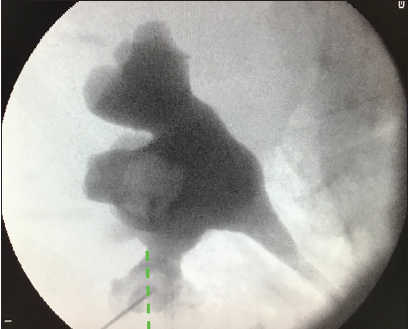Objective: The supine position is becoming increasingly popular in percutaneous nephrolithotomy (PNL). Renal puncture is the key step for a successful PNL procedure. The aim of this study was to describe a novel method for renal puncture and compare it with a previously described method.
Material and methods: Data of 358 patients who underwent PNL in the supine position were collected prospectively. In 165 patients, the puncture was performed by a previously described method (Group 1), and in 193 patients, the puncture was performed with the novel method (Group 2). Groups were compared with regard to total time and fluoroscopy time to successful puncture. In the novel puncture technique, the needle is advanced toward the targeted calyx under monoplane fluoroscopy. To determine the needle depth, the C-arm is rotated by 10°. If the needle projection is beyond the targeted calyx in fluoroscopy, the puncture is deeper than desired. If the needle projection does not reach the targeted calyx, the puncture is more superficial than desired.
Results: Groups were similar with regard to the mean age, gender distribution, body mass index, stone size, and site of puncture. The mean total time to puncture was 88.2±25.3 seconds in Group 1 and 54.3±22.3 seconds in Group 2, and the difference was statistically significant (p=0.03). The mean fluoroscopy time to puncture was 16.1±5.3 seconds in Group 1 and 9.3±3.4 seconds in Group 2, and the difference was statistically significant (p=0.03).
Conclusion: This novel method to determine the depth of the needle is simple, reproducible, and has the potential to diminish radiation exposure with the aid of intermittent fluoroscopy.
Cite this article as: Gökce Mİ, Gülpınar Ö, Akpınar Ç, Tangal S, Süer E, Göğüş Ç, et al. Description of a novel method for renal puncture in supine percutaneous nephrolithotomy and comparison with a previously described method. Turk J Urol 2019; 45(6): 444-8.

.png)
.jpg)
.png)
.png)
